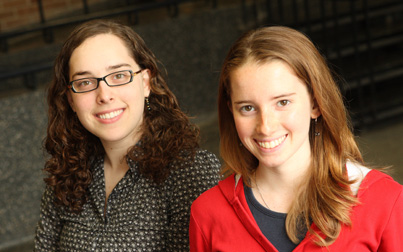Notes from the Field: Science journalists-in-training
Notes from the Field: Science journalists-in-training McGill University
User Tools (skip):
NOTES FROM THE FIELD
Science journalists-in-training

On the science beat; Paloma Friedman and Kirsten Dorans.
Owen Egan
As more news appears online for free, print newspapers are losing readers. Despite efforts to keep subscribers, newspaper downsizing is inevitable. Science stories, which appeal to a small audience, are often the first to go. Given this, we wondered: are science journalists an endangered species?
To see if science journalism is a viable career option, we traveled to this year's American Association for the Advancement of Science (AAAS) conference, held in Boston from February 14-18. The AAAS meeting gathers over 10,000 scientists annually from all fields, and more than 1,000 registered press cover the event. As McGill undergraduates studying math (Paloma) and chemistry (Kirsten), we became interested in science writing by participating in WARM-SPARK (Writing About Research at McGill-Students Promoting Awareness of Research Knowledge).
A travel stipend from the AAAS and the National Association of Science Writers (NASW) funded our trip to Boston. In addition to the stipend, the NASW paired us with established science journalists who escorted us to press conferences, introduced us to their colleagues, and explained how to adapt to transitions underway in the media. Kirsten's mentor was Michael Woods, a former newspaper science editor. When his newspaper closed its bureau, Woods went to work at the American Chemical Society. He joined the ranks of many former staff writers who now freelance or work for professional organizations and universities.
According to Woods, the key to keeping up with media's move to the digital world is to find new ways to tell a science story by using new media formats. Multimedia like slideshows, audio, or video clips can enhance a story by bringing it to life. In the media workroom, alongside traditional print writers we saw reporters blogging and podcasting.
But multi-sensory techniques should not eclipse a story's substance. The public needs science journalists to help explain the implications of the many advances in research. An effective science journalist transforms complex ideas into pertinent terms the public can understand.
Science journalist and WARM-SPARK mentor Hannah Hoag freelances from Montreal. According to Hoag, policy makers and the public need to have a better grasp of new science discoveries that have an impact on their lives.
Encountering science journalists with different backgrounds and attending the conference gave us hope that the future of science journalism looks promising with rewarding career options still available. "My job allows me to cover a wide range of science and keeps me be at the leading edge," Hoag said. "And you meet some great characters along the way."
Kirsten Dorans and Paloma Friedman are WARM-SPARK writers. WARM-SPARK (Writing About Research at McGill-Students Promoting Awareness of Research Knowledge) is a program supported by the Vice Principal (Research Office), Associate Vice Principal (Communications), the faculties of agricultural and environmental sciences, arts, engineering, medicine and science. Their travel to Boston was funded by the AAAS and the NASW. They plan on pursuing careers in journalism.

